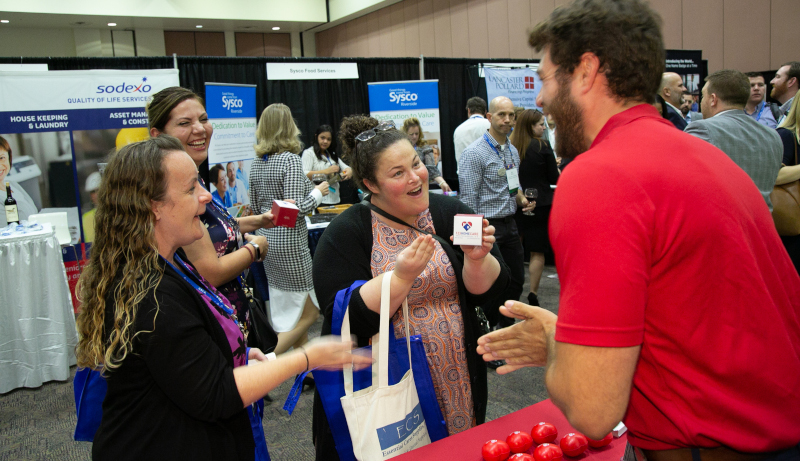The California Assisted Living Association
By Sally Michael, President
The California Assisted Living Association (CALA) is the only association solely representing California’s Residential Care Facilities for the Elderly (RCFEs), which encompass Assisted Living, Memory Care, and Continuing Care Retirement Communities (CCRCs). CALA represents over 625 providers and more than 150 associated businesses. Our provider members range from small, independently operated communities to large, multi-national organizations, and from providers that cater to an active lifestyle to ones that specialize in caring for residents with dementia.

Sally Michael, President
Since 1995, CALA’s mission has been dedicated to the betterment of Assisted Living, Memory Care, and CCRCs in the state. The organization achieves this through leadership to providers and other stakeholders in these residential settings, advocacy to protect the interests of providers and the people they serve, and education to support high-quality programs and services.
RCFEs provide a special combination of housing, personalized supportive services, and 24-hour staff designed to respond to the individual needs of those who require help with activities of daily living. These senior housing options are non-institutional, home-like settings that promote maximum independence and dignity for each resident and encourage family and community involvement. Services can be personalized to align with residents’ needs and preferences, and variations in size, amenities, services, and pricing enable consumers to choose an environment that they consider attractive, a community that meets their needs, and pricing that works for them.
Quality of Life
These senior living options also help promote quality of life for hundreds of thousands of California’s seniors and their families, as a 2016 study by ProMatura found. The study, commissioned by CALA, was based on responses to questions that were designed to determine whether residents felt a sense of belonging, and whether or not they experienced a sense of control over their lives. Belonging and control, according to researchers, create the most telling picture of the role senior living plays in a resident’s quality of life.
In order to measure residents’ sense of belonging, ProMatura asked questions such as whether staff members were friendly, whether they had made friends with other residents, and whether they were comfortable with the people in their community. An overwhelming majority of residents—98 percent—said the staff members in their communities were friendly, and 95 percent said they were comfortable with the people who work and reside in their community. What’s more, 93 percent had made friends with other residents.
In order to measure residents’ sense of control, ProMatura asked participants whether they have choices in their daily life, whether they receive the help they need, and whether they receive the privacy they want. A majority of residents—91 percent—felt they had choices in their daily life. Ninety-four percent felt they received the help they needed while at the same time maintaining the level of privacy they wanted. Given that the overwhelming majority of participants felt both a sense of belonging and control, it is clear that senior living providers in California are providing a high quality of life for their residents.
Maintaining that high quality is important as senior living grows steadily in response to the aging of the population. Since 2005, the California Department of Social Services reports that an additional 1700 RCFEs have been licensed, adding the capacity to care for an additional 23,000 residents. According to the California State Plan on Aging, California is home to more than six million people age 60 or older. By 2050, that population is expected to reach 13.9 million, an increase of 179 percent from 2010. In addition, the population of Californians 85 and older is expected to grow from 600,000 in 2010 to over 2 million in 2050. As those numbers increase, so too will the demand for senior housing and services.

Workforce Development
A higher demand means the need for a larger workforce. In fact, during CALA’s 2016 strategic planning meeting, workforce was the issue that rose to the top of all the discussions. In addition to the jobs and team members needed to care for the growing population of residents, the CALA Board of Directors identified challenges with recruitment stemming from the need for a bigger talent pool and a general lack of awareness of senior living as a career option.
To meet those challenges, CALA’s Workforce Development Committee created a new suite of web-based tools and resources. Housed on the CALA website, they include a toolkit to launch an internship program, talking points for introducing senior living careers to students, and online professional development courses for current employees. While they have only been available since April of 2018, members are already putting them to use.
Another avenue for widening the talent pool has been the CALA Scholarship Fund. Every year, thanks to generous support from members, the Fund gives students and recent graduates with an interest in the senior living profession the opportunity to attend a CALA conference. The experience has proven to be a successful avenue for meeting new potential employees. According to a 2017 scholarship recipient and now employee of a CALA-member community, “It was at this conference that I solidified my passion for senior living… I truly do feel that I have found the ‘perfect fit’ in my professional career.”
Staff Training
CALA-member communities share the common goal of providing excellent service, care, and support to their residents. In keeping with this goal, the extensive training requirements established for staff and administrators—including initial and ongoing education and testing—ensure that they are well-trained to meet the needs of residents.
In 2014, CALA sponsored and supported legislation that greatly increased the training required for California’s RCFE employees. As sponsor of AB 1570 (Chapter 698, Statutes of 2014) and supporter of SB 911 (Chapter 705, Statutes of 2014), CALA fought for a doubling of the training hours required to become certified as an administrator, as well as an increase in the length of the administrator exam and the integrity of the exam questions themselves. In addition to working with stakeholders on legislation to quadruple the training required to be an RCFE caregiver and significantly increase the training required for staff assisting residents with medications, CALA also joined with the Alzheimer’s Association to increase dementia care staff training and expand the training to all RCFEs, not just those that advertise dementia care (AB 1570 (Chapter 698, Statutes of 2014)).
Emergency Preparedness
Always a high priority for CALA members, emergency preparedness has become even more crucial in the past few years as California has faced wildfires, floods, and other natural disasters. While many providers routinely go above and beyond, it was recognized that existing emergency preparedness laws and regulations were lacking. Therefore, with support and active involvement from members, CALA sponsored AB 3098 (Friedman) in 2018 to help strengthen emergency preparedness for all RCFEs.
In addition, CALA formed a task force to learn from members who experienced disasters. The result was a suite of resources our members can use to strengthen their training and planning. These can now be found on CALA’s Emergency Preparedness webpage, and include a guide for developing or revising an emergency and disaster plan, a list of web resources for things such as emergency alerts and recovery services, and an index of types of emergencies providers may face.
AT A GLANCE
WHO: California Assisted Living Association
WHAT: An association representing California’s Residential Care Facilities for the Elderly
WHERE: Sacramento, California
WEBSITE: www.caassistedliving.org



